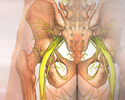Back pain - when you see the doctor
When you first see your health care provider for back pain, you will be asked about your back pain, including how often and when it occurs and how severe it is.
Your provider will try to determine the cause of your pain and whether it is likely to quickly get better with simple measures, such as ice, mild painkillers, physical therapy, and exercise.
-
Information
Questions your provider may ask include:
- Is your back pain on one side only or both sides?
- What does the pain feel like? Is it dull, sharp, throbbing, or burning?
- Is this the first time you have had back pain?
- When did the pain begin? Did it start suddenly?
- Did you have an injury or accident?
- What were you doing just before the pain began? For example, were you lifting or bending? Sitting at your computer? Driving a long distance?
- If you have had back pain before, is this pain similar or different? In what way is it different?
- Do you know what caused your back pain in the past?
- How long does each episode of back pain usually last?
- Do you feel the pain anywhere else, such as in your hip, thigh, leg or feet?
- Do you have any numbness or tingling? Any weakness or loss of function in your leg or elsewhere?
- What makes the pain worse? Lifting, twisting, standing, or sitting for long periods?
- What makes you feel better?
- Does bearing down or straining make your pain worse?
You will also be asked if you have other symptoms, which may point to a more serious cause. Tell your provider if you have had weight loss, fever, a change in urination or bowel habits, or a history of cancer.
Your provider will perform a physical exam to try to find the exact location of your pain, and determine how it affects your movement. Your back will be pressed on at different spots to find where it hurts. You will also be asked to:
- Sit, stand, and walk
- Walk on your toes and then your heels
- Bend forward, backward, and sideways
- Lift your legs straight up while lying down
- Move your back in certain positions
If the pain is worse and goes down your leg when you lift your legs straight up while lying down, you may have sciatica, especially if you also feel numbness or tingling going down the same leg.
Your provider will also move your legs into different positions, including bending and straightening your knees.
A small rubber hammer is used to check your reflexes and to see if your nerves are working properly. Your provider will touch your skin in many places, using a pin, cotton swab, or feather. This reveals how well you can feel or sense things. Your provider may also scratch the bottom of your feet to see whether you have the right reflexes.
References
Dixit R. Low back pain. In: Firestein GS, Budd RC, Gabriel SE, Koretzky GA, McInnes IB, O'Dell JR, eds. Firestein & Kelley's Textbook of Rheumatology. 11th ed. Philadelphia, PA: Elsevier; 2021:chap 50.
Qaseem A, Wilt TJ, McLean RM, Forciea MA; Clinical Guidelines Committee of the American College of Physicians. Noninvasive treatments for acute, subacute, and chronic low back pain: a clinical practice guideline from the American College of Physicians. Ann Intern Med. 2017;166(7):514-530. PMID: 28192789 pubmed.ncbi.nlm.nih.gov/28192789/.





